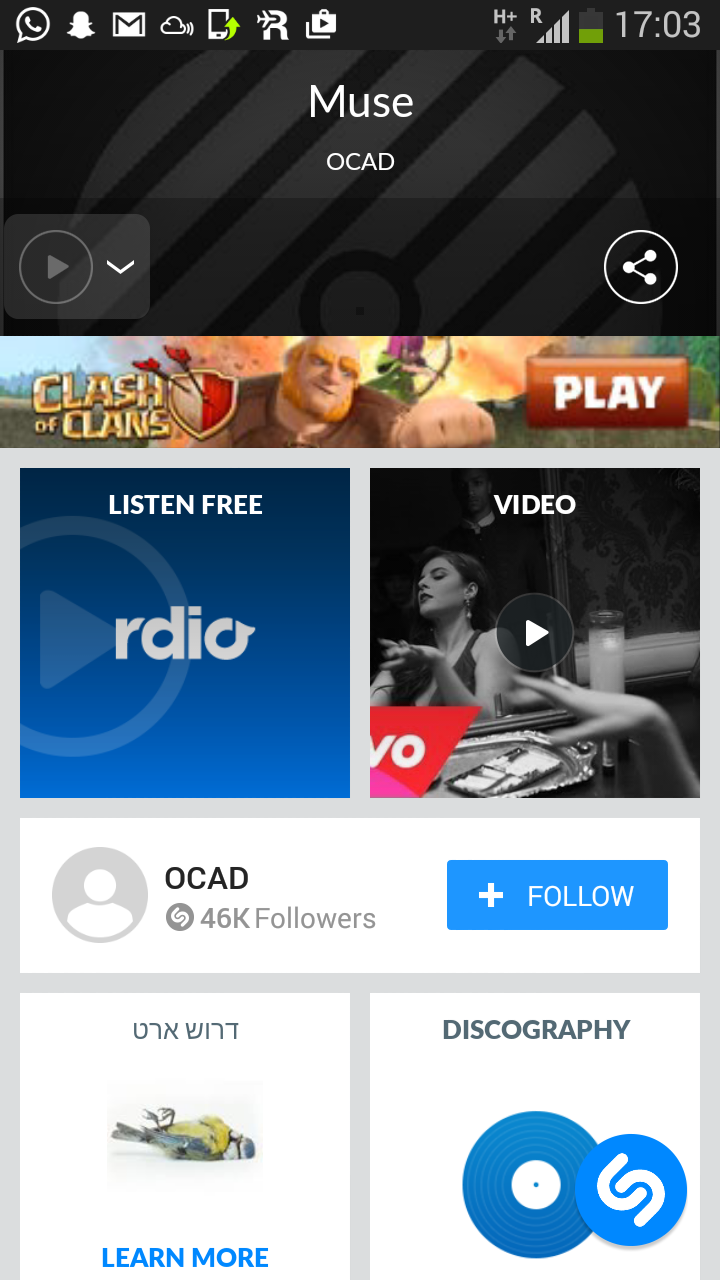In an era when all internet services reincarnate into a one-feature mobile app, Shazam, a true mobile-first app since 2002 (!), is going the opposite direction. Social layers and handful of integrations are constantly added on top of what was once just a blue button that magically tells you what you are listening to. Will those features drive up engagement? Here’s why I think they won’t:
Too many features!
To name just a few, the new Shazam offers Rdio, Spotify and Apple Music integration, a social feed, embedded YouTube, related songs, lyrics, Shazam for movies and TV and a QR reader (!). There’s also an option to view charts, create playlists and buy tickets for concerts. This abundance results in a cluttered UI and overall clunky user experience. For example, users instantly “follow” musicians they tag. But what exactly does “follow” mean? That I’m going to see whatever these artists tag from now on? Well, half of the artists I follow are already dead, so unless Shazam is going to pull a Tupac on every dead celebrity on my list I really don’t know what to expect. Another thing is the ads. Shazam has to make money, and apparently being responsible for 8% of all global music downloads is not enough. I don’t have any problem with ads, however, the way they are presented in Shazam is a little bit too crowded for those with chubby fingers.
Broken feedback loop
The default first page of Shazam displays a social feed where users can see what their friends have Shazamed. Currently, the feed resembles the early feed days of Facebook where notifications consisted of automatic actions such as “John joined the product management group” or “3 of your friends are going to X event.” Those automatic notifications are, first of all, not that interesting. Apparently I don’t care much for what my friends are Shazaming. The second, bigger problem with automatic notifications, is that they are, well… automatic. Users do not take an active part in the upload process, and thus don’t feel emotionally invested in it. Unlike crafting a tweet or shooting an Instagram, Shazams just happen. This results in a broken feedback loop as users don’t feel that burning sensation to check on how their content is doing, like they would on other social networks. On top of that, Shazam does not give the option of liking or commenting on other users’ tags, which means that there’s no interaction whatsoever between users.
Connection with artists
Lastly, Shazam is offering a new take on the artist-fan relationship. Now, fans can follow their favorite musicians and see what they are Shazaming. This may be perceived as interesting data that will help music discovery, Shazam’s bread and butter. But how fun is it? How engaging? Peeking into my favorite artists’ Shazams seems like a good idea, but a lot depends on how they (the artists) will use it. Will they Shazam carefully now that they know they are being stalked? Would it turn into a commercial thing too soon? Again, the biggest problem here is the same problem that the social feed suffers from. How interesting is it in the long run? This is miles away from watching Taylor Swift’s life snippets on Instagram or reading Kanye West’s narcissistic tweets. Shazam’s feed, at the moment, looks like a musical grocery list.
What can be done?
The biggest challenge for Shazam on their way to becoming a social app is finding a way for their users to get creative around the music tags they upload. There are various ways to do that. Giving the option to record a video while Shazaming is one of them. A still picture with the music track on it would also do. Adding a geo-location tag to that would make it sweeter. Altering the picture after taking it? Even better. This would help tagging the musical moments as memories, something like a musical diary, rather than just a list. Anything to add more soul to the anemic tagging would give users reasons to go in and see how their content is doing socially.
Shazam, with its 100M MAU and out-of-this-world technology, has the potential of being the music-based social network of our generation. But I believe a few more iterations are needed before they (and us) get there.
What do you think of the new Shazam? Do you like it?
Tell me in the comments.

